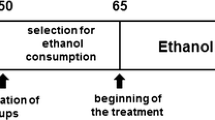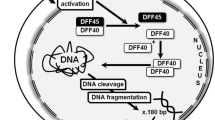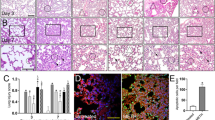Abstract
We examined whether methamphetamine (MAP) induced apoptotic cell death in vivo. Male Wistar rats were injected intraperitoneally with 25 mg MAP/Kg body weight and were sacrificed at 4, 8 and 24 h. As early as 4 h after a single dose of MAP, DNA ladder bands representing DNA fragmentation into multiples of the internucleosomal DNA length of about 180 by were observed by gel electrophoresis in thymic and splenic DNA. DNA from control rats injected with 1 ml physiological saline/Kg body weight showed no ladder band patterns. The proportion of fragmented DNA from the thymus increased in a time-dependent manner up to 8 h and faint ladder band patterns were observed at 24 h, indicating that cell death via apoptosis occurred at an early stage and then apoptotic bodies were scavenged. DNA fragmentation in the thymus and spleen induced with MAP was also confirmed by the terminal deoxynucleotidyl transferase-mediated dUTPbiotin nick end labeling (TUNEL) method in situ. In control thymus samples, stained cells were numerous in the cortex but sparse in the medulla. At the boundary area between the cortex and medulla, stained cells were seen as a layer. In the MAP-treated rats, stained cells were increased and dispersed equally in the cortex and medulla. In control spleen samples, stained cells were numerous in all areas excluding the germinal centers. Cells at the germinal centers were stained intensively in MAP-treated rat spleen. Light microscopical analyses allowed us to identify lymphocytes during the course of apoptotic cell death. Electron microscopic studies showed morphological landmarks for the process of cellular apoptosis in both organs e.g. lymphocytes with chromatin condensed into crescents at the periphery of the nuclei and apoptotic bodies. These results indicate that MAP induced cell death of the thymic and splenic lymphocytes via apoptosis.
Similar content being viewed by others
References
Arends MJ, Wyllie AH (1991) Apoptosis: mechanisms and roles in pathology. Int Rev Exp Pathol 32: 223–254
Arends MJ, Morris RG, Wyllie AH (1990) Apoptosis: the role of the endonuclease. Am J Pathol 136:593–608
Balster RL (1991) Drug abuse. In: Wingard Jr LB, Brody TM, Lamer J, Schwartz A (eds) Human pharmacology molecularto-clinical. Mosby Year Book, St. Louis Baltimore Boston Chicago London Philadelphia Sydney Toronto, pp445–1161
Cohen JJ (1991) Programmed cell death in the immune system. Adv Immunol 50:55–85
Cohen JJ, Duke RC (1984) Glucocorticoid activation of a calciumdependent endonuclease in thymocyte nuclei leads to cell death. J Immunol 132:38–42
Cohen GM, Sun X-M, Snowden RT, Ormerod MG, Dinsdale D (1993) Identification of a transitional preapoptotic population of thymocytes. J Immunol 151:566–574
Freire-Garabal M, Balboa JL, Núñez ML, Castaño MT, Llivo JB, Fernández-Rial JC, Belmonte A (1991) Effects of amphetamine on T-cell immune response in mice. Life Sci 49:PL107-PL112
Fuchs B, Pruett SB (1993) Morphine induces in murine thymocytes in vivo but not in vitro: involvement of both opiate and glucocorticoid receptors. J Pharmacol Exp Ther 266:417–423
Gavrieli Y, Sherman Y, Ben-Sasson SA (1992) Identification of programmed cell death in situ via specific labeling of nuclear DNA fragmentation. J Cell Biol 119:493–501
Graybill AM, Moratalla R, Robertson HA (1990) Amphetamine and cocaine induce drug-specific activation of the c-fos gene in striosome-matrix compartments and limbic subdivisions of the striatum. Proc Natl Acad Sci USA 87:6912–6916
Hurd YL, Ungerstedt U (1989) Ca2+ dependence of the amphetamine, nomifensine, and Lu19-005 effect on in vivo dopamine transmission. Eur J Pharmacol 166:261–269
Kerr JFR, Wyllie AH, Currie AR (1972) Apoptosis: a basic biological phenomenon with wide-ranging implications in tissue kinetics. Br J Cancer 26:239–257
McConkey DJ, Nicotera P, Hartzell P, Bellomo G, Wyllie AH, Orrenius S (1989) Glucocorticoids activate a suicide process in thymocytes through an elevation of cytosolic Ca2+ concentration. Arch Biochem Biophys 269:365–370
Roitt IM (1994) The acquired immune response. In: Roitt IM (ed) Essential immunology. Blackwell Scientific, London Edinburgh Boston Melbourne Paris Berlin Vienna, pp145–240
Searle J, Kerr JFR, Bishop CJ (1982) Necrosis and apoptosis: distinct modes of cell death with fundamentally different significance. Pathol Annu 17:229–259
Surh CD, Sprent J (1994) T-cell apoptosis detected in situ during positive and negative selection in the thymus. Nature 372:100–103
Williams GT (1991) Programmed cell death: apoptosis and oncogenesis. Cell 65:1097–1098
Wyllie AH, Duvall E (1992) Cell death. In: McGee JO'D, Isaacson PG, Wright NA (eds) Oxford textbook of pathology, Vol 1. Principles of pathology. Oxford University Press, Oxford New York Tokyo, pp 141–157
Wyllie AH, Kerr JFR, Currie AR (1980) Cell death: the significance of apoptosis. Int Rev Cytol 68:251–306
Wyllie AH, Morris RG, Smith AL, Dunlop D (1984) Chromatin cleavage in apoptosis: association with condensed chromatin morphology and dependence on macromolecular synthesis. J Pathol 142:67–77
Yonehara S, Ishii A, Yonehara M (1989) A cell-killing monoclonal antibody (anti-Fas) to a cell surface antigen co-downregulated with the receptor of tumor necrosis factor. J Exp Med 169:1747–1756
Ziv I, Melamed E, Nardi N, Luria D, Achiron A, Offen D, Barzilai A (1994) Dopamine induces apoptosis-like cell death in cultured chick sympathetic neurons — a possible novel pathogenetic mechanism in Parkinson's disease. Neurosci Lett 170:136–140
Author information
Authors and Affiliations
Rights and permissions
About this article
Cite this article
Iwasa, M., Maeno, Y., Inoue, H. et al. Induction of apoptotic cell death in rat thymus and spleen after a bolus injection of methamphetamine. Int J Leg Med 109, 23–28 (1996). https://doi.org/10.1007/BF01369597
Revised:
Issue Date:
DOI: https://doi.org/10.1007/BF01369597




